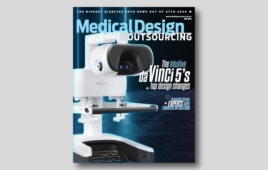
[Image from Abbott]
Dr. John O’Connell, Abbott
For more than 50 years, left ventricular assist devices (LVADs) have helped to extend and improve heart failure patients’ lives by assisting their hearts in pumping blood. Originally, LVADs enabled physicians to save patients’ lives for short periods of time only – they were considered a temporary solution for those that needed heart transplants. Now, advances in design and functionality allow LVADs to be used long-term. With an eye toward progress, clinical and engineering communities are currently exploring where the technology is headed over the next decade.
Previous generations: Pulsatile pump to continuous flow
First introduced in the 1960s, the LVAD was initially intended to support patients pending myocardial recovery, or heart failure reversal. Although they were huge advances, early LVAD models featuring a pulsatile pump had some limitations: Battery life (an hour or two at most) and patient mobility. In fact, the device was so cumbersome that patients struggled to eat a full meal because the pump encroached on their digestive space.
The second-generation LVADs, which debuted in the early 2000s, were continuous axial-flow devices that improved on the pulsatile devices but posed a risk of blood clot formation and driveline infection where the LVAD motor connects to its external power source. Patients also exhibited nonphysiologic flow (minimal pulse pressure, if any); combined with the high shear forces generated, this played a role in increased GI bleeding. To combat these negative side effects, scientists and engineers worked to develop a pump that would not clot and would be more compatible with a patient’s natural bloodstream.
Today’s LVAD: Centrifugal pump
What makes this generation unique is its centrifugal pump, which spins in a circular fashion, ensuring blood does not become static to reduce the chance of clotting. The rotor is suspended magnetically to ensure it remains centered regardless of speed. Due to its large gaps, magnetic suspension is less traumatic to the blood and allows variable speeds to generate a “pulse” of 30 beats per minute. This flushes the pump out to reduce stasis and the risk of thrombosis. The latest model also extends battery life, reducing the patient burden of recharging and swapping out batteries.
Engineers are taking the next major step forward by creating a smaller pump that requires less wattage – allowing for total battery implantation and safer recharging, less-invasive implantation procedures and greater patient freedom – and that’s more compatible with a heart recovering from failure.
Looking ahead: Designing the LVADs of the future
Engineers and clinicians envision a device that’s more invisible to the patient and adaptable to the unique physiologic demands of each person. This next-generation LVAD would be fully implantable (to reduce infection risk) on both the left and right sides of the heart, with multiple feedback mechanisms to automatically regulate pump functions.
Twenty years ago, helping an advanced heart failure patient live for more than a year was considered a medical feat. Today the majority of patients live an average of two years with an LVAD as they await transplantation. Thanks to the hard work of today’s clinicians and engineers, that number will continue to improve in years to come.
Dr. John O’Connell was named VP, Medical Affairs & Medical Director, Mechanical Circulatory Support for St. Jude Medical (now Abbott) as part of the Thoratec acquisition in October 2015. Prior to joining Thoratec Corporation in October, 2013, Dr. O’Connell served as a heart failure cardiologist for 33 years.




